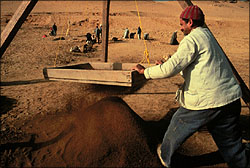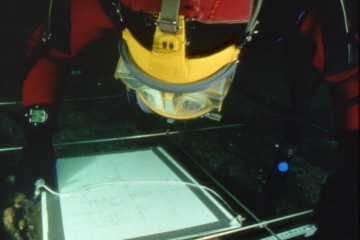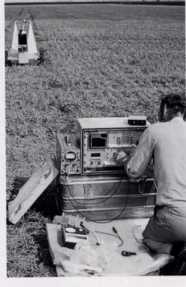Technology has come a very long way from the time that archaeologists were grave robbers and more interested in gold. Way back when, technology wasn't much except for a bunch of garden tools: shovels, picks, brushes, sieving tools...
Many of these are still being used today, but there are also newer tools. Computers have played an integral part in archaeology. Before computers, artifacts were catalogued by hand and written on cards, a very inefficient method. Now, reports on artifacts can be recorded onto a computer and a digital picture can be taken of it. The new method of using computers is quicker, safer, and lasts longer than paper cards do, plus it is easier to add onto a computer than a card, which must be rewritten.

Here is the only method for sieving. It is one of the older procedures, but no new way has been found to better perform this task. This picture was taken on site in Egypt by Mark Lehner on his excavtion by the pyramids.
Also, marine archaeology has come a long way from its very beginnings too. Interest in marine archaeology picked up mostly from interest in the lost city of Atlantis and in the interest of learning more about ancient ships. More and more coastal cities were being discovered. Techology developed for more efficient methods of excavating underwater sites because of the need for better equiptment to measure, record, and possibly bring up artifacts from the water.

Here is a new way of recording notes underwater, at the Alexandria site in the South Mediterranean Sea.
New satelitte technology makes it easier to locate harder to see or reach sites. Using satelittes, archaeologists can map out where they want to start looking for an axcavationn site. They can also look for patterns in the surrounding area.

Surveying has also found new and more improved techniques to make the site safer and to make sure that less artifacts are destroyed. Probably the newest technology which is still in its testing stages, is geophysical surveying that uses neuron scattering or gamma rays. The reasons these are still in their testing stages are because the results have been below archaeologists' satisfaction. Various types of echo-sounding are also being used and are most useful in underwater reconnaissance.

This is an example of soil sounding radar. It is a modern geophysical instrument that can detect archaeological remains underground by bouncing radio waves off them. This machine in particular was recently used for excavations at Sutton Hoo.
Updated lab techniques are also extremely important. Newer and newer dating technologies are being created to provide more and more accuracy. Probably the most useful new dating technique is Thermolumenescence dating. TL dating is what archaeologists have been hoping for, it dates pottery. There is a far more detailed description of dating in the Lab section of this web site.
Click here to go back to the Home Page!